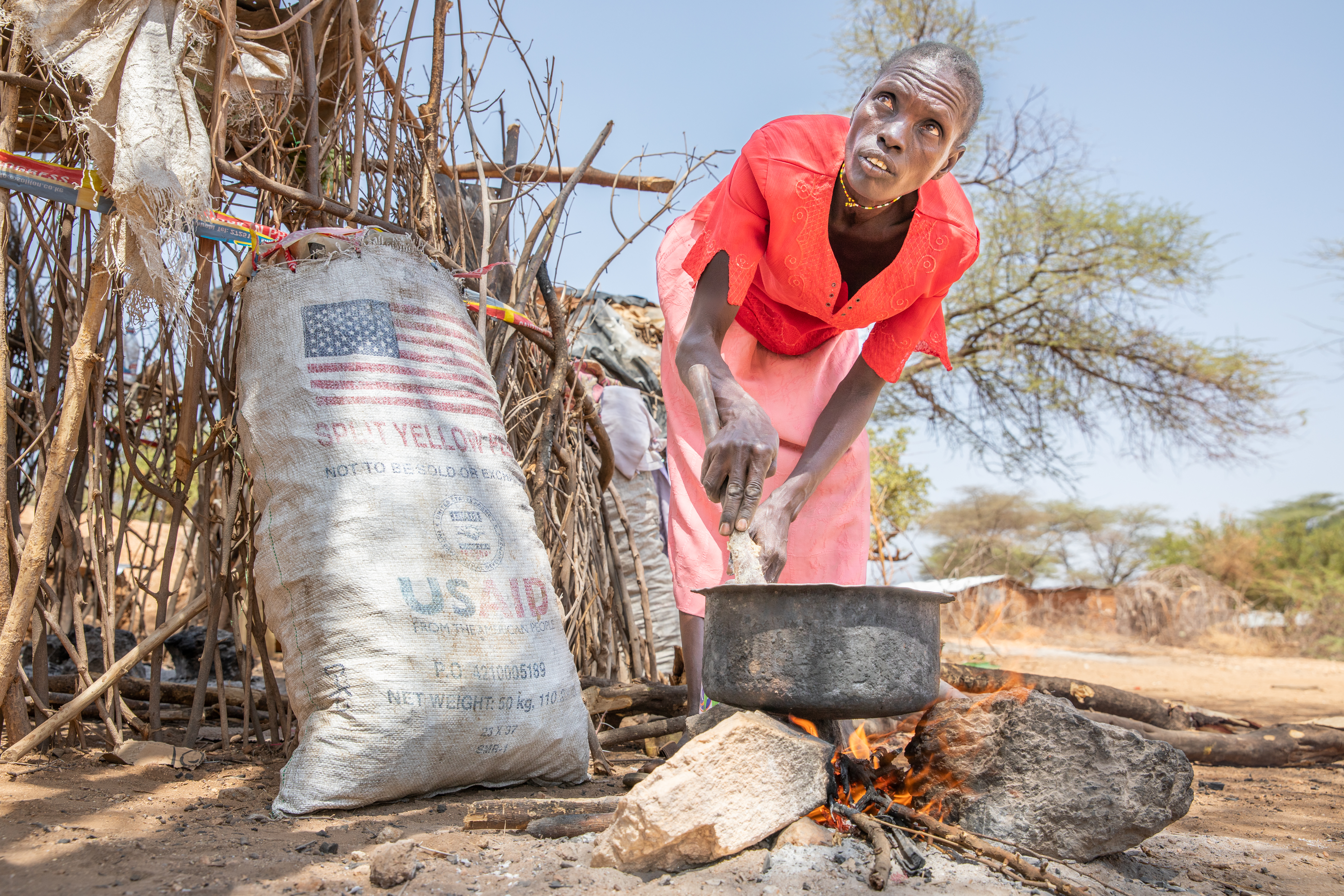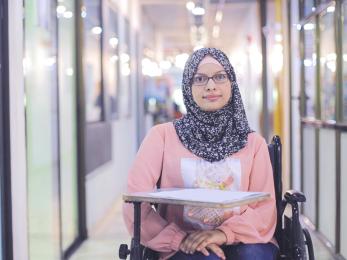How restoring a school is reviving hope in Somalia
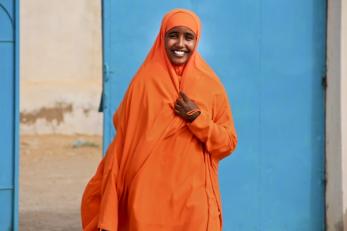
In the Hamar Weyne district of southeastern Mogadishu, home to many of the city’s most vulnerable and diminished communities, stands a beacon of hope.
Amid piles of rubble, bullet-pocked buildings and rubbish-lined streets, the newly-restored Moalim Jama secondary school is open for classes for the first time in more than two decades.
Inside the freshly-painted bright blue building, 229 students sit in rows of new desks learning math, Somali and chemistry, and hoping to build a better life in a fragile community where sporadic attacks are still a harsh reality.
Moalim Jama is now the only public secondary school in Somalia’s war-torn and battered capital city.
School rehabilitations like this one are part of Mercy Corps’ initiative to provide Somalia’s vulnerable young people with the educational resources they need to build — and eventually lead — a strong and just nation.
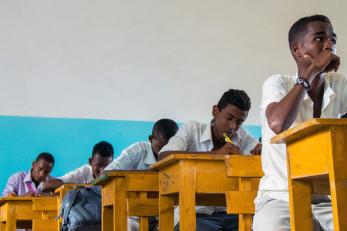
“For children who have only known war and conflict in their lifetime, a good quality education offers Somali youth hope for a better future,” says Olad Farah, Mercy Corps Program Director.
“Through education, they will lead more productive lives and get meaningful employment. They will also be able to change the direction of their lives by simply gaining the skills to contribute positively to their communities.”
And as we observe our 10-year anniversary in the country this month, we celebrate the reopening of Moalim Jama — alongside a decade's worth of success and progress.
Somalia has huge challenges, and huge potential
Somalia plunged into chaos after the breakdown of the central government in 1991, and the country has since been home to intense violence, poverty, extremism, civil warring, natural disasters and famine.
Social services, including education, disintegrated after the collapse. More than 75 percent of the public schools that previously existed in the South Central region — home to Mogadishu — have been closed or destroyed. Only 19 percent of the population in this area can read and write.
Nationwide, deeply entrenched barriers like conflict, inadequate facilities, distance, expensive fees and a lack of teachers and materials continue to keep young people from receiving an education. Faced with early marriage and domestic responsibilities, girls are even less likely to attend.

According to The World Bank, less than half of Somali children are enrolled in primary school, and only 12 percent of males and 8 percent of females are enrolled in secondary school (comparable to grades 9-12).
Marked by high levels of poverty, malnutrition, illiteracy, unemployment and displacement, Somalia is one of the five least-developed countries in the world, as indicated by the 2012 Human Development Index.
But the tide is slowly turning.
Rebuilding a city begins with a school
Just over three years ago, a new, internationally-backed federal government was put in place in Mogadishu, setting the foundation needed for eventual peace and stability.
“Mogadishu is a bustling city that is struggling to rebuild itself,” Olad says. “There is a lot of development and slowly the physical signs of the war are being erased.”
“Speaking to the locals, they believe Mogadishu has never been safer and people are able to go about their everyday business,” he continues. “There are also new restaurants, hotels and businesses sprouting across the city, which bring about an air of hope.”
Moalim Jama secondary school is a symbol of this progress.
One of the oldest public schools in Mogadishu, Moalim Jama had been destroyed by years of conflict. Before Mercy Corps, recently helped renovate it, the building sat in ruins, serving instead as a decrepit, makeshift shelter for hundreds of people who had been displaced by violence.
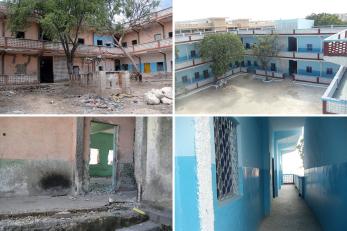
But through a local government initiative, the families living there were relocated. With funding from USAID, we were able to restore the school’s grounds, repair the classrooms and bathrooms, install desks, and provide textbooks and other materials for learning and teaching.
In October 2014, Moalim Jama’s first students in 24 years— 100 of them — enrolled to begin classes. The school’s opening marked the first time South-Central residents have had a functional public secondary school system since the fall of the government.
Even more significant is that it serves the city’s most poverty-stricken and marginalized populations.
Strong youth to build a strong country
In addition to refurbishing and furnishing secondary schools, we’re working to improve formal teacher training by implementing courses in core subjects like math and science, as well as classroom management and teaching skills, in official training institutes across the country.
This project focuses, especially, on supporting and training new female teachers. In the male-dominated Somali education system, female teachers can provide emotional support for female students, champion their specific needs, like proper bathroom and washing facilities, and serve as role models, all of which increase the likelihood that girls will complete their education.
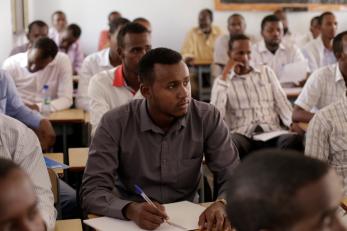
And for young people who have no official schooling — due to poverty, forced marriage, displacement or other obstacles — we facilitate non-formal education in learning centers throughout the country. At the centers, uneducated youth can receive basic numeracy and literacy training, as well as life skills education like conflict resolution and reproductive health.
More than 70 percent of Somalia’s population is under the age of 30, yet educational and employment opportunities are slim. Instead, many hopeless youth stay trapped in the poverty, violence and instability that have plagued Somalia for so long and continue to do so still.
That’s why we’re determined to open new doors for them. And the gates of Moalim Jama are just the start.
Through the USAID-funded Somali Youth Leaders Initiative, we’ve rehabilitated classrooms in 43 secondary schools, trained hundreds of professional teachers and provided tens of thousands of students with access to the quality education they need to build a better future for themselves.
It’s our goal that, one day soon, they’ll use it to build a stronger country, too.
Learn more about our efforts to improve access to education around the world ▸
